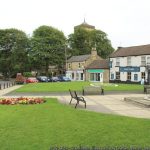Portsmouth – The Island City
Much like Manhattan, the city of Portsmouth lies on an island all of its very own. A short 20 miles jaunt south and east of Southampton. This island city was built on Portsea Island, in the English Channel. It has some special claims to fame. It is the only city with more people per foot in the UK than London, it is home to the oldest drydock in the world, and it was home to the first-ever mass-production system.
If you have a bit of love for Portsmouth and you want to learn more then read on. Whether you are a resident of just visiting, this place has a lot of history worth familiarising yourself with… so why not join us for the Five Minutes Spare Guide.
Once Upon a Time in Portsmouth…
It is reckoned that the Romans used this area all the way back in their 1st-century invasions. They built a fort on the end of the channel, some four miles south of Portchester. The very name of Portsmouth comes from the Old English and means the safe place at the end of the estuary… or something like that.
The Romans were here for a few hundred years until they retreated, leaving behind a fort that is recorded as in the hands of the Britons as of 501 AD. Not much is known of the early times, but it is speculated that the position of the fort led to be fruitful. A town grew up around it as people moved towards the protection. As happened throughout the rest of England, the Vikings then came and ransacked it.
It was in the 8th century the Danes first arrived. They landed around the Portsmouth area and assaulted the fort, capturing it. They used this area as a base to then raid outwards to the nearest towns and cities. The king at the time sent an army who beat them back. They vanished for a hundred years or so, then returned with much the same tactic. This went on until Bannockburn. In the Domesday Book there is no mention of Portsmouth, although it does talk about two other towns that would have been in the same area.
The Vikings basically sacked the place so much that everyone moved away. At some time back then the town’s nickname was acquired. It is sometimes called Pompey. It is thought that this comes from the abbreviations commonly used to describe Portsmouth Point. It is thought this is used on Navigational Charts so often that it caught on inland. It is also the name of a French canon ship that was captured at the turn of the 18th century.
Portsmouth In the Dark Ages
Portsmouth was officially founded in 1190 by the same merchant who owned land in Normandy. He founded a little town on the corner of Portsea island and assumed it was all his idea. Evidently, this is how long it takes for humans to remember why something was a bad idea.
He wanted the area because it was a great place for a port, so he built one. In 1188 the settlement had grown so much that it needed its own church; which would later develop into Portsmouth Cathedral! This building isn’t just still in use today – it is the mother church of the Diocese and one of Portsmouth’s best attractions.
That little town started in the 12th century was then attacked repeatedly by the French. Although one of Britain’s most important ports of the times, it is though the population was somewhere just over a thousand folk. In 1418 the town leaders built a tower in the harbour, designed to defend the entrance. It was built to house two cannon that would watch for any more Frenchmen.
The plot thickened in 1450. A Bishop had arrived in town to pay the sailors but did not bring all of what he owed them. They dragged him into the street and stabbed him. Until 1508 the whole town was not allowed to hold any religious sacraments as punishment. It would have been considered a devil’s town in those days. So if you live in Portsmouth there is a high chance you are unholy…
In 1497 the drydock produced its first warship, the Sweepstake, proving the French were right to keep attacking it and some 40 years later Southsea Castle was built after Henry VIII dissolved the monasteries. He expanded the town and there is a sad story about him watching his flagship sink from the towers there.
The Plague in Portsmouth
The bubonic plague came to ever port city in Britain and Portsmouth was no exception. There is a record of 300 people out of a 2000 population in 1563. Although the population density was not what it was now back then, the town still suffered from various outbreaks.
In early years a Domus Dei had been opened in Portsmouth. This was the place where lepers would be kept, outside of town and isolated. Now every port town in England claims to be the entry point for the black plague in 1348, but Portsmouth is one of the furthest south points and has as likely a claim as any. Clergy records of the time tell us that some fifty percent of the church was killed.
It is thought that Portsmouth Domus Dei was infected by plague carriers making their way from Portsea to Winchester or Canterbury, and vice-versa. The disease spread to the port. In the 1563 outbreak of plague, Henry VIII had already closed the Domus Dei. Yet the plague came again.
Cholera Strikes
In 1849 the town was similarly affected by a cholera outbreak. The church reported around 800 people buried. As with the earlier plague outbreaks, more un-consecrated space had to be taken to bury people in. The church was not allowed to extend their graveyard as it would have taken up the market space.
Part of the reason for all these outbreaks might have been in the morbid way they treated criminals. In 1628 on of the King’s closest men was assassinated in a house in Portsmouth. Not only was the perpetrator caught and hanged, but he was also left to decompose in his chains as a warning to obey. Later, when the 1642 civil war broke out, the town surprisingly sided with the king. It had been placed under a military leader and was a garrisoned port.
Unfortunately, the guns at Southsea castle were turned on the town and the military leader was forced to surrender. Later, Charles II would be married in the town. In 1667 it became one of the most fortified towns in Europe as the monarchy finally recognised the importance of its location.
Famous Folk from Portsmouth
Let’s break up all this lovely history by discussing some of the claims to fame found in this seaside city. There have been hundreds of famous people born in Portsmouth over the years – not to mention those that have been immortalised through assassination. Some of our favourite famous folk from Portsmouth include:
- Charles Dickens was born here. Locals nickname it Pompey and so did he… then he went on to write Oliver Twist!
- The Comedian Peter Sellers was born here.
- There are hundreds… Roland Orzabal from Tears for Fears was born in Portsmouth, as was Brian Howe from Bad Company, Roger Hodgson of Supertramp, and DJ Hixxy…
You can find a full list of famous people born in Portsmouth (UK) on Wikipedia.
The Industrial Revolution
As with all cities in Britain, the Industrial Revolution hit Portsmouth in a big way. They had a port already but being a shipbuilding town really put them on the map. St. Anne’s church was built in 1704 and that started an expansion of the city that lasted nearly two hundred years. Houses were added to accommodate a Naval Academy, which was opened in Portsmouth because the harbour was so vital.
The houses shot up at such an alarming rate in the late 17th century that the governor threatened to turn the harbour canon on any new houses. By 1704 the people had sought royal permission to build without being shot. The people had their houses and the suburb was named Portsmouth Common. It later became Portsea, as it remains today.
The town walls were eventually rebuilt to encapsulate these new houses – but not until the population grew to more than 20,000 people. About the same time the harbour was so heavily fortified it earned a ranking as one of the best defended in the world. The HMS Bounty (from Mutiny on the Bounty) set sail from their harbour in these years.
It is thought that the whole of Portsea Island wasn’t covered by Portsmouth until the turn of the 19th century. In 1811 it got its first water supply and a few years after a philanthropic townsman opened up the countries first ragged school. These were schools for children who had nothing. Lighting arrived in 1820, sewers in the 1860s. Despite this, there was another cholera epidemic. After 800 people died the council made it law that any home within 100ft of a sewer needed to be connected to it.
A further smallpox epidemic in 1872 saw a further 500 people die. At this point it was the busiest port in Britain and the authorities put more work into improving public health. This outbreak was the last of its kind.
The Wars in Portsmouth
As well as being attacked, pillaged, and burned to the ground several times throughout history; Portsmouth also made major contributions to every single war overseas. When troops are sent to war, they are usually sent via the harbour here.
The city was allegedly bombed in the first world war, well according to Zeppelin records anyway, although the towns own records show no such bombing. Sadly there are very few people around to give a first-hand account so we will leave that open to debate. Anyway, when the Zeppelins did do damage it tended to only be two or three deaths per city, still sad but possibly not as noteworthy as other events occurring at the time.
Some 1200 ships were repaired in the Portsmouth docks during WWI, making it one of the most strategically important harbours in Europe… It is thought the bombs were dropped on the harbour instead of on the docks. Whatever the answer, no damages were recorded.
The Second World War, however, hit Portsmouth much harder. In four years, the Luftwaffe attacked and bombed them a reported 67 times. Around 6,625 houses were left in ruins and 930 deaths were recorded. In one terrible night in 1941, the raids killed 171 people and destroyed 3000 homes. To this day, unexploded bombs are occasionally dug up, however, don’t use this as an excuse not to visit as they are always dealt with.
Whole sections of the city were rebuilt afterwards after a survey in 1955 found that 7000 of the council houses were unfit for habitation. After all of this Portsmouth’s role in the war effort wasn’t finished and they contributed ships & men to the Falkland War effort in 1982. The city of Portsmouth remains the primary home of the British Royal Navy. Officers are still trained here and, no doubt, if we run into another war, this is where the troops will ship out from.
In 2001 the shoreline was redeveloped, and retail estates were added.
, then saw the last sailing of the Yacht Britannia in 1997.
Fun Facts from Portsmouth
As well as having an illustrious history and plenty of famous people, there are also some interesting facts regarding Portsmouth out there. Let’s split up the doom and gloom of war and the thrill of Portsmouth attractions with a little fun. Here are a few Five Minutes Spare favourites:
- Both H G Wells and Sir Arthur Conan Doyle lived and worked in the area. Wells reportedly said it was one of the most depressing places he had been to. He hated it, but it would have been densely populated and dirty in his day.
- The last person to be arrested for Witchcraft in Britain was in Portsmouth, 1735. Her name was Victoria Helen McCrae Duncan. She was a medium.
- The first floodlit football match was played here in 1956. It’s so dark in the winter in Britain it is no surprise we would come up with stadium lighting…
- Portsmouth harbour processes 100% of the Jersey potatoes in the UK.
You can find some more Portsmouth fun facts over on iNews.
Attractions in Portsmouth
So if you are spending some holiday time in the south of the UK, what should you get up to? Here are our favourite Portsmouth attractions to give you something to do!
This is a must-see. At one of the oldest drydocks in the world you can’t just come here and miss it out. It is where Nelson’s flagship was built, where the first Iron Clad Warship was built, and is packed full of historical statues, figures, and interactive exhibits. The National Museum of the Royal Navy is in the dock yard.
If seafaring and history are what tickles your fancy, stop in to the Portsmouth Guildhall. Now a music and corporate event venue, this impressive building was once home to the merchants and traders that would have called this port home. It was rebuilt after the Second World War and all those bombings, so it isn’t original – but it is striking.
Fort Nelson is in Portsmouth. It was built in the 1860’s and houses over 350 canon and artillery pieces. It’s one of the most informative free things to do in Portsmouth, so go along and see the big guns. There is a D Day Story Museum on Clarence Esplanade that opened in the eighties to commemorate that fateful day. It was the farmers and fishermen of Portsmouth that sailed across the channel and brought our men back when there weren’t enough boats.
Henry VIII’s greatest fortified Castle is still standing, still in use, and still retains the features that made it so fabulous in the first place. Visit them to find out about Tudor history, enjoy the fantastic coastal views, and learn all you need to know about the city. They also make craft beer…
There are plenty of things to do in Portsmouth if you have kids. The Blue Reef Aquarium is one of our favourites. This place has more than 40 displays of living sea creatures. If you have the backbone you can even get in alongside them for a swim! If that’s not to your liking, the Mary Rose is on display in its own museum. Kids love the spooky mystery of what happened to her. Once Henry VIII’s flagship, she vanished in the 15th century and was brought up from the ocean floor in the 80’s.
If you can’t afford to fork out for such things, then a simple trip to Southsea Beach might make a kid’s day. A day spent climbing Portsdown Hill to see the view is also free. A trip to Staunton park to feed the ducks or enjoy a picnic could also be on the cards if you get good weather.
Port Solent
The boardwalk and Port Solent have some of the best shops in the city. This area was redesigned to be a retail centre and attract people to the area. You can also visit Cascades Shopping Centre or get some designer goods out of Gunwharf Quays, the more up-market retail centre.
Where to Eat, Drink and Party in Portsmouth?
So where do you go to eat in this town? If you are looking for the upscale meal of your life, try the Restaurant 27. They received a 2 Rosette rating, a Michelin Plate award from 2019, and a string of other awards accumulated over the years. It is the best of the best. Treat yourself.
For something less expensive; they have a whole range of fast food outlets in the retail parts. The Florence Arms Gastro Pub is worth a look,. As is Becketts. For a good night out though, you need good cocktails. Customer reviews put these in the gin & Olive in the Southsea part of the city.
As to nightclubs; you can party the night away at either the Astoria or the Lyberry. Either will guarantee you make new friends and enjoy the best nightlife in Portsmouth. The Astoria is also an event venue so you may find something extra special is on during your stay… fingers crossed!
Other Notable Portsmouth Attractions
Portsmouth is packed with all sorts of fun things to do. Here are a few more that we just couldn’t cover in more detail:
- The King’s Theatre – catch a show at any time of the year… but they are best known for pantomimes in the Winter.
- The Southsea Model Village is a lovely place. Make sure you park and walk.
- Clarence Pier is aging a little now but you can still catch the odd attraction. It’s fun in a nostalgic kind of way. It remains one of the biggest amusement parks on the south coast.
So there is always something to do in town, no matter whether you have the cash or not.
How to Get There?
So how do you get to this wonderful city? Follow these generic instructions…
By Road
Follow the M3 or the M275 south and west out of London. The 275 will take you to Portsmouth first; the M3 will take you through both Winchester and Southampton on the way there.
By Rail
You can get off at any number of Portsmouth Train Stations. If you cannot get a train directly from London head to Southampton and change.
By Air
Fly to either Southampton airport or, to save cash, any of the London airports and get a bus.
By Sea
Portsmouth Harbour is open to all and is the favoured place to cross to the Isle of Wight. You can head for Portsmouth Harbour, which has its own railway station.
Got Five Minutes?
If you have enjoyed this article and want to share it around a little, we won’t stop you. We also encourage you to head over to our main pages for other trivia, news, and local guides. The internet is for sharing information and we try our best to make it fun.




